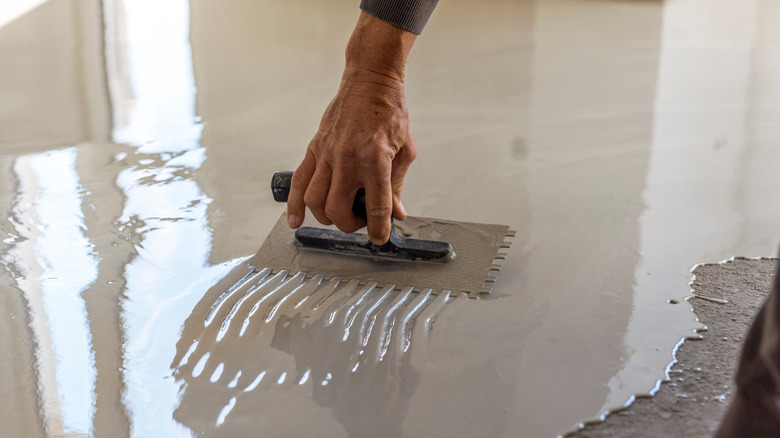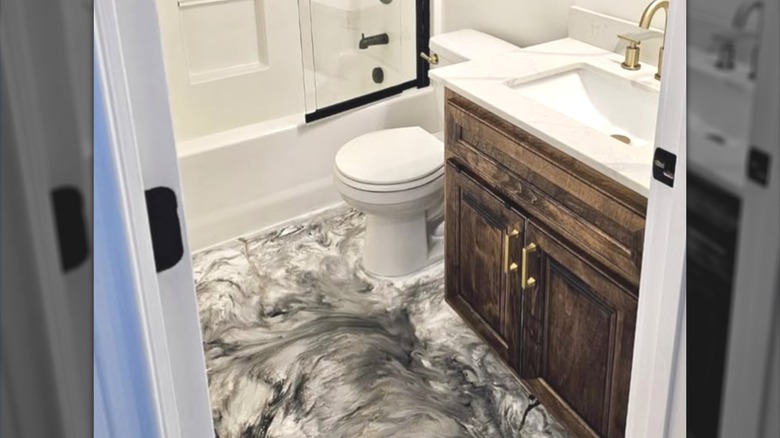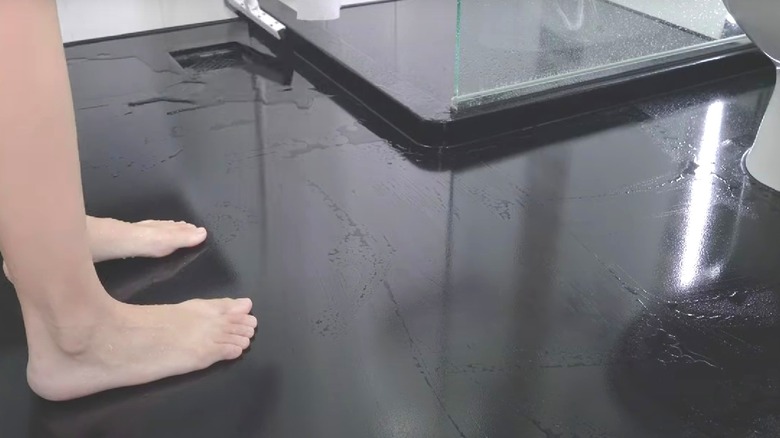The Pros And Cons Of Epoxy For Your Bathroom Floor
If you're researching the best materials for renovating your bathroom floor, you might find yourself intrigued by smooth and stylish epoxy flooring and wonder if this modern material could work for your bathroom. Made with pourable and self-leveling synthetic resin, epoxy is indeed a popular flooring choice for commercial bathrooms. In residential spaces, you'll commonly see epoxy flooring in garages or basements, but some modern homes are bringing this futuristic material to their water closets.
Overall, epoxy flooring isn't a bad choice, but there are a few things to carefully consider before dumping a gallon of the product onto your bathroom floors. At its best, epoxy flooring can provide an all-around convenient flooring solution — it is waterproof, affordable, long-lasting, and available in a wide range of colors and styles. However, there are also some drawbacks to using this material, especially in bathrooms. For example, epoxy flooring is difficult to install on your own and can be nearly impossible to remove after it's cured. At its worst, this material can have a sinister side that raises health and safety concerns.
Epoxy floors are affordable, low-maintenance, and stylish
One factor that draws people to epoxy flooring is its price. Installing your own epoxy flooring costs around $2 to $5 per square foot, but hiring a professional is also rather affordable, adding only about $1 to $7 per square foot in labor fees. If properly done, using epoxy over existing tile floors can be a smart idea to save time and money. Once cured, epoxy floors are low-maintenance, durable, potentially waterproof, and resistant to stains and chemicals. With proper care, these floors can last well over 20 years in most homes. Cleaning these floors is easy; just sweep and mop with warm water and a diluted ammonia floor cleaner for a streak-free finish. In small or windowless bathrooms, the shiny epoxy surface can bounce more light up into the space.
Besides the practical benefits, there are countless ways to customize epoxy flooring in your bathroom, whether you prefer a more luxe, contemporary, or creative aesthetic. Epoxy flooring can flow from the bathroom floor into the shower and even up the walls for a seamless shower look. If you hate stepping out of a warm shower and onto the chilly bathroom floor, epoxy floors are also appropriate for installing underfloor heating. Epoxy is available in a wide range of colors, opacities, and finishes. Depending on the application method, epoxy flooring can be swirled to mimic expensive marble, mixed with glitter, or sprinkled with terrazzo-like speckles. You can even apply clear epoxy over wallpaper or flat objects like pennies.
Epoxy flooring can be unsafe and is practically permanent
While it is possible to DIY your epoxy bathroom floors, doing so presents unique challenges. Epoxy floor installation requires some special equipment, such as a power washer, epoxy rollers, spiked shoes, and more. Priming your floor is necessary when installing epoxy floors, increasing the time and effort it takes to achieve that professional, seamless look, and epoxy's long curing time could put your bathroom out of commission for up to 72 hours. As it cures, epoxy can release toxic volatile organic compounds (VOCs). The floors can continue off-gassing for a while after they've hardened. In rare cases, individuals can develop respiratory problems or contact dermatitis due to the chemicals used in epoxy resin, which is especially bad news for barefoot bathroom visitors.
A more common downside to this unique material is that it becomes slippery when wet, so it's not a very safe choice for bathrooms. The shiny epoxy surface can make it difficult to see puddles, quickly turning a peaceful shower into late-night emergency room visit. However, opting for a non-slip surface texture can help mitigate this risk.
Even if you love your epoxy bathroom floors in the beginning, they can become a major headache down the line. In bathrooms with bright windows, humidity and UV light can damage and discolor the flooring over time. While it can be recoated, this flooring is almost impossible to remove because epoxy forms a chemical bond with the surface beneath it. If you're committed to epoxying your bathroom floors, you'd better choose a style you love and hope you never spring a leak under the foundation.


